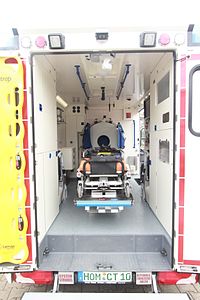
Photo from wikipedia
Introduction: Disparities in acute ischemic stroke (IS) care due to patients’ pre-stroke disabilities remain understudied. Using the Greater Cincinnati Northern Kentucky (GCNK) Stroke Study, we aimed to understand the differences… Click to show full abstract
Introduction: Disparities in acute ischemic stroke (IS) care due to patients’ pre-stroke disabilities remain understudied. Using the Greater Cincinnati Northern Kentucky (GCNK) Stroke Study, we aimed to understand the differences in acute stroke presentation and care according to patients’ pre-stroke functional status. Methods: We ascertained all hospitalized IS patients ≥18 years old presenting to emergency departments in the GCNK region in 2015 using ICD-9 430-436; ICD-10 I60-I67, G45-G46; all cases were physician-reviewed. Trained nurses ascertained pre-stroke functional status from the medical record. Acute IS presentation, time metrics, and treatment were compared between patients with pre-stroke mRS 0-1 vs ≥2 using Wilcoxon rank-sum or chi-square tests. Logistic regression was used to evaluate the association between pre-stroke mRS and intravenous thrombolysis (IVT) and endovascular treatment adjusting for age, presenting NIHSS, time to presentation, and baseline anticoagulation use. Results: Of 2191 patients with IS, 1134 had a pre-stroke mRS ≥2. Patients in the latter group were older, more likely be female, had higher rates of medical comorbidities, had higher presenting NIHSS (3[1-8] vs 2[1-5], p<0.01, Table). They were less likely to receive IVT (aOR 0.43[0.28-0.68], p<0.01, for patients presenting within 0-4 hours) and EVT (aOR 0.32[0.13-0.78], p=0.01, for patients presenting within 0-23.5 hours). They had a higher rate of presentation via EMS, but the time from stroke onset to ED presentation was longer. Conclusions: Acute IS patients with pre-stroke disability presented later, with more severe strokes, and were less likely to receive reperfusion treatments. Further research into factors driving acute stroke medical decision-making for patients with a pre-stroke disability is needed to ensure optimal acute neurovascular care for all IS patients across the nation and worldwide.
Journal Title: Stroke
Year Published: 2022
Link to full text (if available)
Share on Social Media: Sign Up to like & get
recommendations!